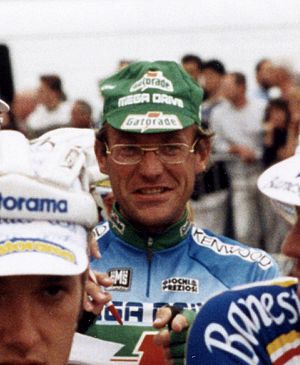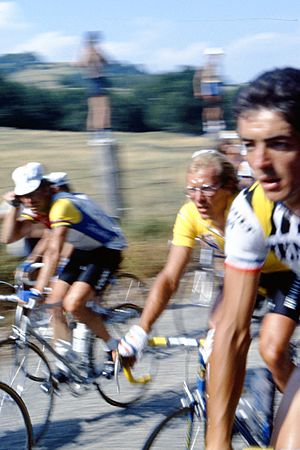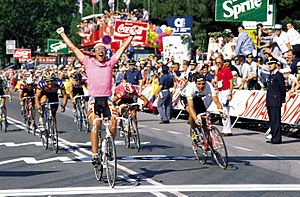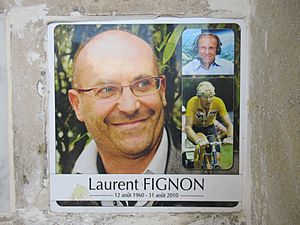Laurent Fignon facts for kids

Fignon at the 1993 Tour de France
|
|||
| Personal information | |||
|---|---|---|---|
| Full name | Laurent Patrick Fignon | ||
| Nickname | Le Professeur (The Professor) | ||
| Born | 12 August 1960 Paris, France |
||
| Died | 31 August 2010 (aged 50) Paris, France |
||
| Height | 1.74 m (5 ft 8+1⁄2 in) | ||
| Weight | 67 kg (148 lb; 10 st 8 lb) | ||
| Team information | |||
| Discipline | Road | ||
| Role | Rider | ||
| Rider type | All-rounder | ||
| Major wins | |||
|
|||
Laurent Patrick Fignon (born August 12, 1960 – died August 31, 2010) was a French professional road bicycle racer. He became famous for winning the Tour de France twice, in 1983 and 1984. He also won the Giro d'Italia in 1989. In 1989, he almost won the Tour de France for a third time. He lost by only 8 seconds to Greg LeMond, which is the closest finish in Tour history. Fignon also won many other important races, including Milan–San Remo two years in a row (1988 and 1989). He passed away from cancer in 2010.
Contents
Early Life and Becoming a Cyclist
Laurent Fignon was born in Montmartre, a part of Paris, France. When he was three, his family moved to Tournan-en-Brie. He lived there until he was 23.
His first favorite sport was football. He even played for his local area team. Friends then got him interested in cycling. He rode his first official race in 1976 and won it! Fignon's parents didn't want him to race at first. So, he raced without them knowing.
He won four more races that first year. In his third year of cycling, he won 18 out of 36 races. After seeing his success, his parents allowed him to race. However, they still wanted him to study. Fignon went to the University of Villetaneuse. He studied Structural and Materials Science. But Fignon wasn't very interested in his studies. He really wanted to be a professional cyclist.
He told his parents he was leaving university. He planned to join the army for his military service. He was sent to the Bataillon de Joinville, which is known for sports. After this, Fignon was sure he wanted to become a professional cyclist.
In 1981, Fignon rode in the Tour of Corsica. This race allowed amateur cyclists to ride with professionals. Fignon tried to keep up with Bernard Hinault, a top professional. He managed to stay with him for much of the race. A few days later, a coach named Cyrille Guimard saw Fignon. Guimard offered him a spot on his professional team, Renault–Elf–Gitane, for the next year. Fignon joined the team in 1982 when he was 21 years old. His friend Pascal Jules also joined.
Professional Cycling Career
1982: First Year as a Pro
In 1982, Fignon rode in the 1982 Giro d'Italia. He broke away in the second stage and became the race leader. This meant he got to wear the pink jersey! He lost the lead in the next stage. But he became a very trusted teammate for Hinault in the mountain stages.
Later that year, Fignon won the Critérium International. This was a great start to his professional career.
1983: First Tour de France Win
In 1983, Fignon helped Bernard Hinault win the 1983 Vuelta a España. Fignon's coach, Guimard, didn't want him to race in the 1983 Tour de France. He thought two big races might be too much for a 22-year-old.
However, Hinault, who had won four previous Tours, couldn't race due to an injury. So, the Renault team needed a new leader. Fignon was chosen for the Tour de France team. The team hoped he or Marc Madiot could win individual stages. They also hoped one of them could compete for the best young rider award.
After stage nine, Fignon was in second place. He was behind Pascal Simon. Fignon was then made the team leader. In stage ten, Simon crashed and hurt his shoulder. Simon kept riding but lost time. In stage fifteen, Fignon won a mountain time trial. He gained so much time that he was less than a minute behind Simon.
In stage seventeen, Simon had to quit the race. Fignon became the new leader! He defended his lead against all attacks. He even won the time trial in the 21st stage. At 22 years old, Fignon was the youngest person to win the Tour de France since 1933.
Fignon later said he was lucky to win the 1983 Tour. If Hinault had been healthy, Fignon would have helped him as a teammate.
With his round glasses and smart look, Fignon was very different from Hinault. He earned the nickname "The Professor." This was not just because of his glasses. It was also because he was one of the few cyclists who had passed his high school exams.
1984: Second Tour de France Win
In 1984, Hinault moved to a new team. Fignon stayed with the Renault team and became their main leader.
In the 1984 Giro d'Italia, Fignon was leading the race. Italian rider Francesco Moser was in second place. A mountain stage, where Fignon could have gained more time, was canceled. Race organizers said it was "due to bad weather." In the final stage, a time trial, camera helicopters flew in front of Fignon. This created a headwind for him. But they flew behind Moser, giving him a tailwind. Fignon was upset, but the helicopters didn't move. Moser gained enough time to win the race. Fignon finished second. He later said this experience made him stronger.
The 1984 Tour de France was a big competition between Fignon and his former leader, Hinault. Hinault won the first short race. But Fignon's team won the team time trial in stage three. This helped Fignon gain time. After stage five, Fignon's teammate Vincent Barteau was leading the race.
In stage seven, Fignon won the time trial. He beat Hinault by 49 seconds. Barteau was still leading after the Pyrenees mountains. In stage sixteen, Fignon again beat Hinault in a time trial. He won by 33 seconds. In stage seventeen, Hinault attacked five times on a tough climb. But Fignon always caught up. Then, Fignon left Hinault behind. He gained almost three more minutes on Hinault. Barteau fell behind in this stage, so Fignon became the new leader. Fignon won three more stages, making it five wins that year. He won the Tour de France by a huge ten-minute lead!
If not for the issues at the Giro, Fignon would have won both the Giro and the Tour that year. He was seen as France's new cycling superstar.
1985 and 1986: Dealing with Injuries
Fignon felt very strong in 1985. But he had two operations on his Achilles tendons. This caused him to miss the 1985 Tour de France. The next year, his team got a new sponsor and became the Système U cycling team. In 1986, Fignon won La Flèche Wallonne. He started the 1986 Tour de France but had to quit in stage 12 due to poor performance.
1987 and 1988: Getting Back to the Top
Fignon got back to his top form in 1987. He finished third in the 1987 Vuelta a España. He was behind Luis Herrera. Later that year, he finished 7th in the 1987 Tour de France. He also won another stage at La Plagne.
In 1988, Fignon won Milan–San Remo. However, he had to leave the 1988 Tour de France early.
1989: Losing by Just 8 Seconds
In 1989, Fignon became the number one ranked cyclist in the world. That year, he won Milan–San Remo again. He also won the Giro d'Italia. During the Giro, he beat riders like Flavio Giupponi and Erik Breukink. Fignon took the pink jersey (leader's jersey) in stage 14 and kept it until the end. He also won stage 20.
In the 1989 Tour de France, the previous winner, Pedro Delgado, was the favorite. Fignon and Greg LeMond were also top contenders. Delgado was almost three minutes late for the start of the first time trial. This opened up the race for everyone. The Tour became a close battle between LeMond and Fignon.
LeMond gained a minute in the stage five time trial. He used special aerobars and a new aerodynamic helmet. Fignon used regular handlebars. LeMond led the race by 5 seconds after that stage. In stage ten, Fignon beat LeMond by 12 seconds. Fignon became the new leader, 7 seconds ahead.
In the stage 15 time trial, LeMond again gained time on Fignon and took back the lead. Fignon fought back by dropping LeMond on the famous Alpe d'Huez climb. He took back the lead. After winning alone the next day, Fignon had a 50-second lead.
Before the final stage, a short 24.5 km time trial, Fignon had a 50-second lead. This seemed like a very safe lead. French newspapers even printed special editions ready to celebrate Fignon's victory. But LeMond rode an incredibly fast time trial. Fignon had developed saddle sores in stage 19. These caused him pain and made it hard to sleep before the time trial. Fignon, who rode after LeMond, lost 58 seconds in the stage. He rode very fast and finished third in the stage. But he still lost the overall lead to LeMond by just 8 seconds.
Some people joked that if Fignon had cut his ponytail, the reduced air resistance might have helped him win. If Fignon had won, it would have been the first time he won both the Giro and the Tour in the same year.
During that Tour, Fignon was not friendly with journalists. He often refused to smile for photos. Once, he even spat at a cameraman who asked for an interview. Because of this, the press gave Fignon the "Prix Citron" ("Lemon Prize"). This award was given to the rider they liked the least. Losing the 1989 Tour was very hard for Fignon. In his book, he said, "you never stop grieving over an event like that."
After the Tour de France that year, he came back strong. He won the Grand Prix des Nations time trial. This was considered the world championship for time trials at the time. This time, he used aero handlebar extensions. He also showed his skills by winning other races like the Polynormande.
1990–1993: Later Years and Retirement
Fignon quit the 1990 Tour de France. But he finished 6th in the 1991 Tour. After this, Fignon joined the Italian Gatorade team. He was a co-captain and helped guide young talent like Gianni Bugno. After a tough 1992 Giro d'Italia, he rode his last Tour that same year. He finished 23rd overall. In that race, Fignon won his ninth stage, holding off many attacks. He won at Mulhouse in stage 11.
Fignon's last victory as a professional cyclist was in the Ruta Mexico in 1993. He had a close race with Francisco Villalobos. He also survived a big crash where a group of riders was hit by a tow truck. Fignon retired from professional cycling in late 1993.
After Retirement
In 1995, Fignon started the "Laurent Fignon organisation." This group organized races, like Paris–Nice. His organization ran Paris–Nice from 2000 until 2002. Then, Amaury Sport Organisation (ASO), which organizes the Tour de France, took over. Fignon continued to organize other races, such as Paris–Corrèze.
Fignon wrote a book about his life called Nous étions jeunes et insouciants. This means "We were young and carefree." It was released in June 2009.
Death
In June 2009, Fignon shared that he was getting treatment for metastatic cancer. Doctors found the cancer in April 2009. They found tumors in his digestive system.
In January 2010, doctors found that the cancer had started in his lungs. Laurent Fignon passed away on August 31, 2010, at Pitié-Salpêtrière Hospital. He was 50 years old. He was survived by his wife, his parents, and his son and daughter from his first marriage.
His funeral was held on September 3, 2010, at Père Lachaise Cemetery in Paris. He was later cremated. His ashes were placed in the columbarium at the Père Lachaise cemetery.
Career Achievements
Major Results
- 1981
- 1st Stage 2 Tour du Vaucluse
- 1982
- 1st
 Overall Critérium International
Overall Critérium International - 1st Flèche Azuréene
- 1st Garancières-en-Beauce
- 1st GP de Cannes
- 1st Stage 1 (TTT) Giro d'Italia
- 2nd Overall Tour du Vaucluse
- 1st Stage 1
- 3rd Overall Étoile des Espoirs
- 1983
- 1st
 Overall Tour de France
Overall Tour de France
- 1st Grand Prix de Plumelec-Morbihan
- 1st Grand Prix Le Télégramme de Brest
- 1st Prologue Tour d'Armorique
- 1st Stage 3 Tour du Limousin
- 1st Stage 1 Critérium International
- 3rd Polynormande
- 7th Overall Vuelta a España
- 1st Stage 4
- 7th Overall Tirreno–Adriatico
- 1st Stage 4
- 1984
- 1st
Road race, National Road Championships
- 1st
 Overall Tour de France
Overall Tour de France
- 1st Stages 3 (TTT), 7 (ITT), 16 (ITT), 18, 20 & 22 (ITT)
- 1st Stage 9 Clásico RCN
- 2nd Overall Giro d'Italia
- 3rd Grand Prix de Fourmies
- 4th Grand Prix Le Télégramme de Brest
- 7th Overall Tour de Romandie
- 1st Prologue & Stage 4
- 8th Liège–Bastogne–Liège
- 1985
- 1st
 Overall Settimana Internazionale di Coppi e Bartali
Overall Settimana Internazionale di Coppi e Bartali
- 1st Stage 4a
- 1st Prologue Étoile de Bessèges
- 2nd Overall Route du Sud
- 1st Prologue
- 3rd La Flèche Wallonne
- 3rd Brabantse Pijl
- 5th Liège–Bastogne–Liège
- 1986
- 1st Stage 2 (TTT) Tour de France
- 1st La Flèche Wallonne
- 1st Bol d'Or des Monédières
- 1st Stage 2 Critérium du Dauphiné Libéré
- 2nd Overall Escalada a Montjuich
- 2nd Overall Tour du Vaucluse
- 2nd Grand Prix des Nations
- 2nd Paris–Camembert
- 7th Overall Vuelta a España
- 7th Overall Three Days of De Panne
- 8th Overall Tour Méditerranéen
- 10th Grand Prix Eddy Merckx
- 1987
- 1st Stage 6 Ronde van Nederland
- 2nd Overall Tour de Luxembourg
- 2nd Overall Étoile de Bessèges
- 1st Stage 3a (ITT)
- 3rd Overall Paris–Nice
- 1st Stages 5 & 7a
- 3rd Overall Vuelta a España
- 3rd Overall Tour du Vaucluse
- 3rd Grand Prix Le Télégramme de Brest
- 5th Overall Critérium International
- 6th Overall Volta a Catalunya
- 6th Liège–Bastogne–Liège
- 7th Overall Tour de France
- 1st Stage 21
- 1988
- 1st Milan–San Remo
- 1st Paris–Camembert
- 2nd Overall Critérium International
- 1st Stage 2
- 2nd Grand Prix de Wallonie
- 2nd Paris–Brussels
- 2nd Grand Prix des Nations
- 3rd Paris–Roubaix
- 4th Overall Route du Sud
- 1st Prologue & Stage 1
- 5th Overall Paris–Nice
- 6th Overall Étoile de Bessèges
- 9th Overall Ronde van Nederland
- 1989
- 1st UCI World Ranking
- 1st
 Overall Giro d'Italia
Overall Giro d'Italia
- 1st Stage 20
- 1st
 Overall Ronde van Nederland
Overall Ronde van Nederland - 1st Milan–San Remo
- 1st Grand Prix des Nations
- 1st Polynormande
- 1st Critérium des As
- 1st Trofeo Baracchi (with Thierry Marie)
- 2nd Overall Tour de France
- 3rd Grand Prix Le Télégramme de Brest
- 4th Overall Tour de Romandie
- 6th Overall Critérium International
- 6th Overall Tour Méditerranéen
- 6th Road race, UCI Road World Championships
- 7th Liège–Bastogne–Liège
- 1990
- 1st
 Overall Critérium International
Overall Critérium International - 3rd Critérium des As
- 4th Overall Paris–Nice
- 8th Overall Route du Sud
- 1991
- 1st Stage 5 Giro di Puglia
- 6th Overall Tour de France
- 10th Overall Paris–Nice
- 1992
- 1st Stage 11 Tour de France
- 8th Overall Euskal Bizikleta
- 1993
- 1st
 Overall Ruta Mexico
Overall Ruta Mexico
- 1st Stage 6
Grand Tours General Classification Results Timeline
| Grand Tour | 1982 | 1983 | 1984 | 1985 | 1986 | 1987 | 1988 | 1989 | 1990 | 1991 | 1992 | 1993 |
|---|---|---|---|---|---|---|---|---|---|---|---|---|
| — | 7 | — | — | 7 | 3 | — | — | — | — | — | — | |
| 15 | — | 2 | — | — | — | — | 1 | DNF | DNF | 37 | — | |
| — | 1 | 1 | — | DNF | 7 | DNF | 2 | DNF | 6 | 23 | DNF |
| — | Did not compete |
|---|---|
| DNF | Did not finish |
See also
 In Spanish: Laurent Fignon para niños
In Spanish: Laurent Fignon para niños




